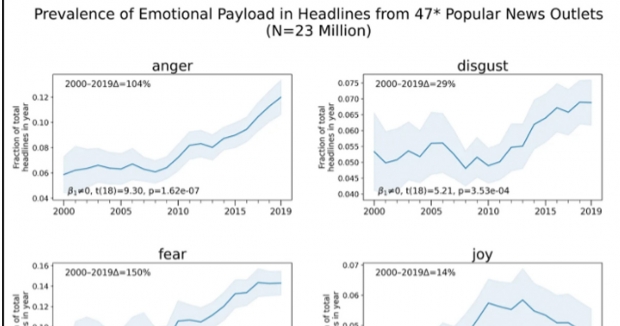Research Shows News Headlines Have Gotten More Negative

New analysis shows news media headlines have gotten more negative over the last 20-odd years.
Using AllSides Media Bias Ratings™ from 2019, researchers analyzed sentiment and emotion in 23 million news headlines from 47 media outlets popular in the U.S. Using AI that detects positive and negative sentiment, as well as six basic emotions — anger, disgust, fear, joy, sadness, surprise — plus neutrality, researchers were able to automatically label the headlines.
They found that there was an increase in negativity in headlines since the year 2000, and a decrease in emotionally neutral headlines. Headlines from outlets AllSides rates as on the right have been, on average, more negative than headlines from left-leaning outlets, according to the AI estimation. In addition, headlines the AI found to indicate anger appeared to be higher, on average, in right-leaning news than in left-leaning news outlets.
(It should be noted that USA Today, Bloomberg, and Associated Press are considered Center outlets in this analysis, as it is based on past AllSides Media Bias Ratings™ from 2019. AllSides actually changed USA Today’s bias rating from Center to Lean Left in July 2021, AP’s bias rating to Lean Left in Aug. 2022, and Bloomberg to Lean Left in 2020.
Graphs from the analysis show a stark uptick in emotions such as anger, fear and disgust since 2000, and a decline in neutral headlines.
David Rozado, one of the researchers, notes, “An important question raised by this work is whether the sentiment and emotionality embedded in news media headlines reflect a wider societal mood or if instead they just reflect the sentiment and emotionality prevalent or pushed by those creating news content. Financial incentives to maximize click-through ratios could be at play in increasing the sentiment polarity and emotional charge of headlines over time. Conceivably, the temptation of shaping the sentiment and emotional undertones of news headlines to advance political agendas could also be playing a role.”
This work measures emotionalism, a type of media bias we outline in our guide to 16 Types of Media Bias. It is often closely tied to sensationalism.
It’s also worth noting that while the research found outlets on the left and right are more emotional, AllSides also considered emotionality when rating the outlets. More emotional outlets are typically rated on the left or right to begin with, so this research seems to underscore that connection.
As the media becomes more negative and emotional, it’s important to get multiple angles on the news. This can help you to put stories into perspective and decide for yourself whether something truly incites anger, sadness, joy, or any other emotion — or if you’re just being told it should.
Julie Mastrine is the Director of Marketing and Media Bias Ratings at AllSides. She has a Lean RIght bias.
This piece was reviewed by Joseph Ratliff, Daily News Editor. He has a Lean Left bias.

July 25th, 2024


July 25th, 2024

July 24th, 2024